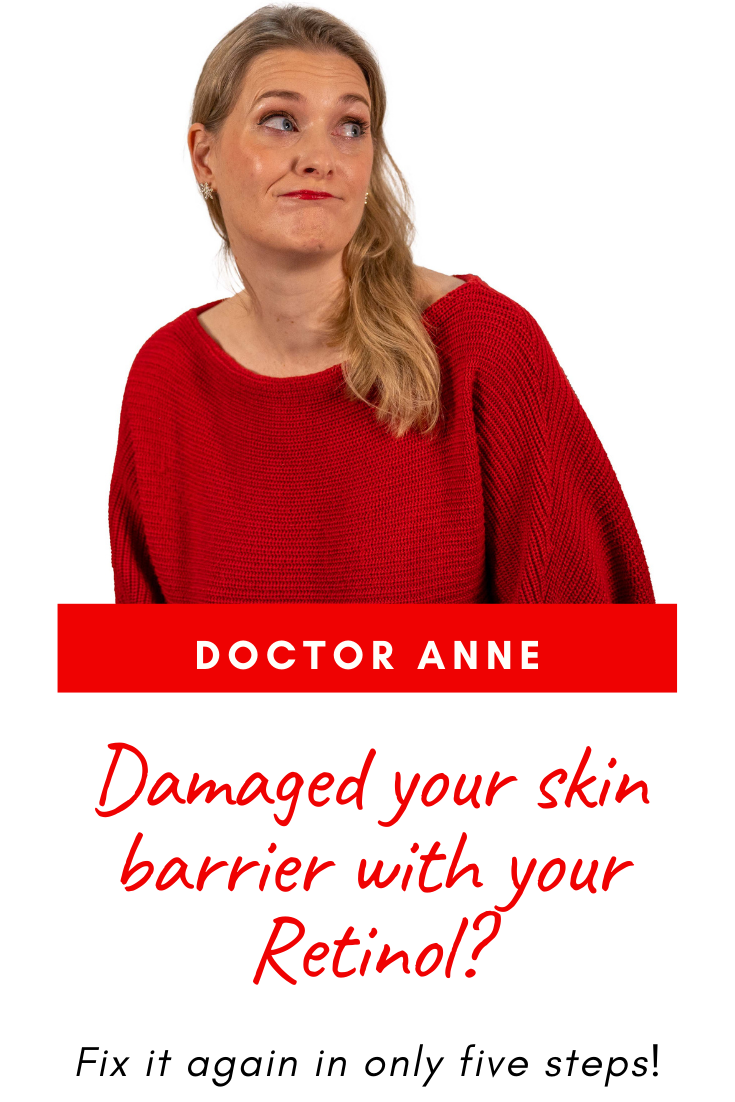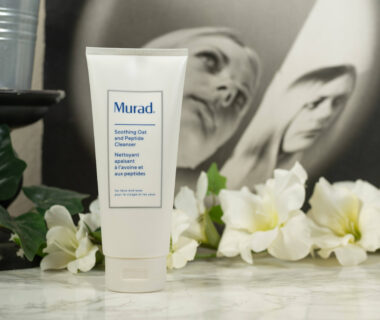ADVERTISEMENT INFO: LINKS USED ARE AFFILIATE LINKS. I RECEIVED NO MONEY TO WRITE THE BLOGPOST. PLEASE READ DISCLAIMER
I know many of you want to use a retinoid in their routine, and I absolutely support that, retinoids are amazing skincare ingredients. (More info: Your comprehensive guide to different types of retinol) But they are also easy to overdo, even if you think you are careful, and I would go as far as saying that each and every one of us will damage their skin barrier by overdoing the retinol eventually. I know I have!

So today let’s talk about the reasons it can happen, the warning signs to look for and most importantly, the five steps you need to take to repair your damaged skin barrier again. (More info: Damaged skin barrier as cause of acne and eczema)
How can you tell you have overdone your retinoid?
We are taught that a little peeling is normal when we introduce strong retinoids into our routine, and to a point it is. Retinoids work by speeding up cell turnover, and until your skin has adapted to that, flaky skin is a common side effect.
When a little peeling occuring in the afternoon suddenly turns into your skin being a flaky mess, when you get redness, dry patches and your skin starts to feel tight, itchy and burn then it is no longer a side effect that will pass, but a warning that you need to stop what you are doing and start repairing.
It can go as far as eczema flare-ups, worsening of acne and your skin being so sensitized that products previously fine will burn when applied. Some people can’t even use plain water anymore.
What happens if your skin barrier is damaged?
Skin is meant to be a barrier, keeping bacteria and potential irritants out and the moisture inside. Retinoids speed up cell turnover, so they can, especially when combined with exfoliating acids, lead to over exfoliation with holes in this barrier. They also trigger the release of so called cytokines, which are inflammatory mediators causing redness and irritation, and inflammation again leads to an impaired barrier function with increased moisture loss.
So your skin loses hydration, gets dry and more prone to wrinkles, and at the same time can’t defend itself against bacteria as well, which leads to infections, or against foreign substances, which can cause irritation and allergies.
How can I prevent that from happening when using retinoids?
I have a blog post on how to introduce Retin-A with minimal irritation here, but even experienced users will wreck their skin barrier from time to time. There are just too many things influencing skin’s resilience, like hormones, stress, the weather and the other products you are using.
The best thing you can do, after following all the tips I gave you in the blog post mentioned above, is keep notes on how you react to potential triggers. I for one know that when it gets cold here in Germany, I need to make some adjustments or my skin will freak out. (More info: Why you need to change your skincare in winter)
I also know that exfoliating more than twice a week will inadvertently cause problems, and I have learned to watch out for early warning signs like sunscreen stinging around the mouth area and immediately react with things to help my skin barrier heal again.
So you wrecked your skin barrier, how do you fix it again?
Healing your skin barrier is pretty easy in the way that you don’t need to do much. In fact, the less you do, the better it is. It is also pretty hard because it requires patience and, well, not doing much.
Here are the five steps you need to take to repair your skin barrier:
-
Stop what you are doing!
Stop everything, your cleansers, your actives, your toners and serums and face masks. Then look at all of them very closely, identifying any thing that could potentially cause trouble right now – I will list a few common offenders now:
1. Retinol
2. Ascorbic Acid
3. AHA
4. BHA
5. Hydroquinone
6. Benzoylperoxide
7. Fragrance
8. Essential Oils
9. Plant Extracts.
Yes, there are many things on this list that I adore and that have a regular place in my routine, but now it is not the time to use them.
-
Build the most boring routine ever!
Strip everything back to the absolute basics: A cleanser, a moisturizer, a sunscreen. Nothing more and most importantly, nothing that contains any of the usual actives.
A gentle, non-foaming cleanser and a very basic moisturizer that is rich in occlusives to create a barrier against moisture loss. (More info: Skinimalism – Does your skincare routine need a diet?) La Roche Posay and Avene make great products for that, as does Cerave – I will link a few options below.
And even if I am usually not against fragrance in skincare, now might be a good time to opt for fragrance free. For sunscreen I stick to my usual one, which is a chemical or a hybrid SPF, but some people find that mineral only will work better for them, especially if you live in the US and don’t have access to the more modern filters used. (More info: Physical, chemical and mineral sunscreen – What is the difference?)
-
Reevaluate your cleansing frequency and method!
If you are using a face brush for cleansing or do scrub your face with a washcloth, stop it. Many people don’t realize that this is physical exfoliation, and right now, anything that exfoliates is not advisable.
Also don’t use hot, but tepid water for your skin, and reduce cleansing to once a day. You can go back to your Double Cleanse if your skin is on the mend again and you are wearing more than your boring routine. (More info: Is Double Cleansing harming your skin?)
-
Look for barrier repairing ingredients!
While your skin will heal on its own, there are a few things that can support it. Look for Niacinamide, Panthenol, Beta-Glucan from Colloidal Oatmeal, Madecassoside from Centella Asiatica and Ceramides. (More info: Ingredient Spotlight Niacinamide, Ingredient Spotlight Colloidal Oatmeal, Ingredient Spotlight Centella Asiatica)
But, and that is one of the most common mistakes I see, don’t purchase new products you never tried before because they contain any of these – now is the time for tried and trusted stuff from your cabinet, not for experimenting with new stuff! One thing that helps me a lot especially during winter is the Zelens Power D Fortifying and Repairing Serum, but the ingredients have less data backup than the other ones mentioned above. (More info: Zelens Power D Fortifying and Repairing Review)
-
Give it time!
How long your barrier will take to heal depends on how much you destroyed it in the first place. If you caught the early signs and reacted immediately, two or three days might be enough. If you really are in deep though, stick to your boring routine for at least two weeks and make sure your skin feels perfectly fine before you, slowly, start reintroducing your other stuff.

Shop some recommendations
Don’t forget to check out the Discount Code Page on top if you want to save some money on your next skincare purchase.
If you want to get a vote in the next Ask Doctor Anne Topic, Ingredient Spotlight or product I review, don’t forget you can head over to my Patreon account to get more involved!


